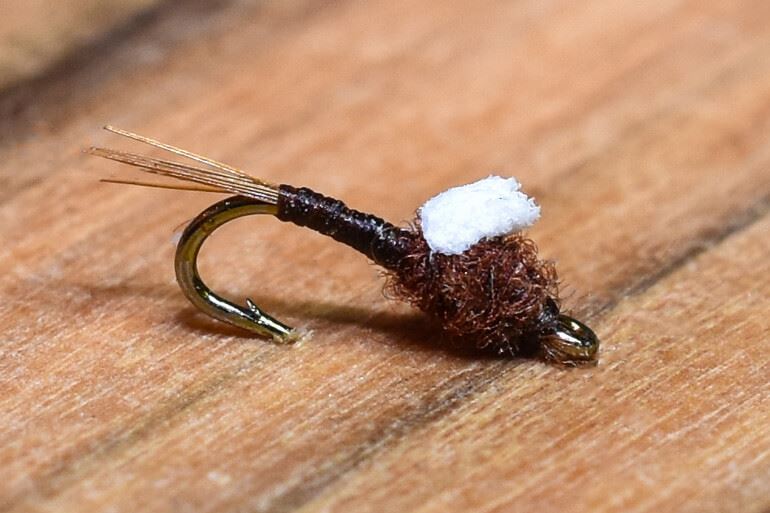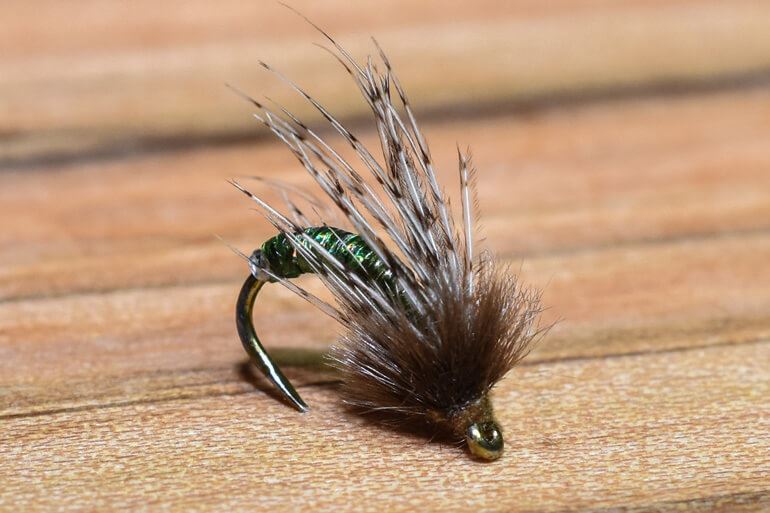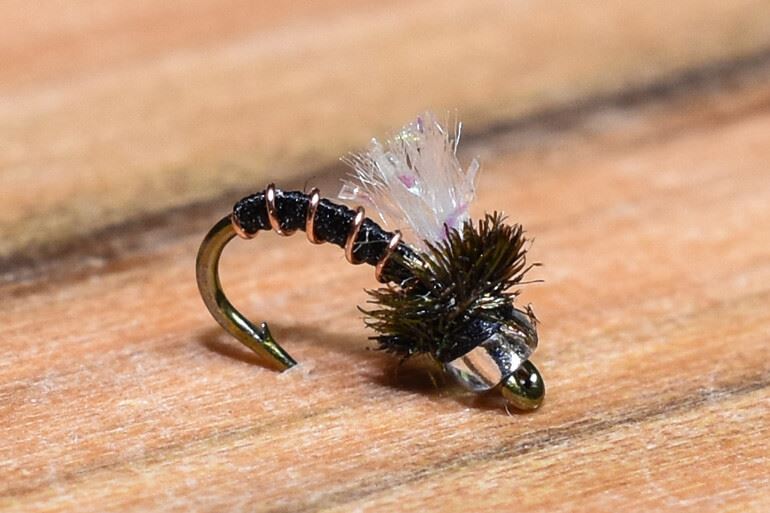Strategies for Suspended Trout
Courtesy of MidCurrent - October 2020; by Pat Dorsey of Blue Quill Anglers
Suspended, feeding trout are not eating along the bottom or taking dry flies from the surface—they’re “tweeners” and they demand a nuanced approach and attention to detail to drift your flies at the right depth. This story was originally titled “Tweeners: Strategies for fooling suspended trout.” It appeared in the August-September 2020 issue of Fly Fisherman.
If you enjoy watching football, you are likely familiar with the term “red zone,” an area of high scoring probability and also compressed defense. With limited room to operate, success is often a game of inches, with little margin for error. There’s a lot of pressure on the offense to score when they are close to the end zone, and walking away without any points is a major disappointment.
My daily routine as a professional fly-fishing guide is similar in many ways. My job is to make sure that when we’re in the red zone, my customers catch fish and hopefully learn a thing or two. As a coach on the field, I get to decide when and where we fish, what flies we use, and the best strategies to fool selective trout. Getting skunked is not an option.
I typically concentrate my efforts in a “feeding zone,” and target active fish that are suspended in the water column. They are there for one reason—to eat—and this maximizes my opportunities to catch fish instead of casting aimlessly and hoping for the best.
Suspended feeding trout require our full attention and best skills because they are not eating on the top, or the bottom—they’re “tweeners” and they require sophisticated tactics and techniques aimed at keeping your flies at the proper depth. Constant adjustments with your weight, strike indicator, and your fly selection to match the hatch are critical for success. Failing to execute is the equivalent of turning the ball over on downs because the fish are clearly in the feeding zone, ready to take your fly if you can make the right play.
Strike Indicators
There are several options to choose from when selecting a strike indicator for tweener nymphing. The most popular are Thingamabobber, Air-Lock, Frog Hair, Fish Pimp, and Poly Vee Rubber O-Ring Yarn strike indicators. Each has trade-offs and compromises. Carefully weigh the pros and cons of each indicator. How quickly can you adjust them? How easy are they to cast? How do they land on the water? How sensitive are they?
The vast majority of strike indicators are made with deep nymphing in mind, and they hit the water too hard to use for suspended trout. When fishing for tweeners, you don’t need to suspend a lot of weight, and you often require a more subtle, stealthy approach.
I believe yarn strike indicators are the best option when it comes to detecting subtle strikes, especially in softer currents where the takes are less obvious. I make my own indicators with three-strand polypropylene craft cord and a 5⁄16-inch rubber band. I separate and insert two strands of yarn (1½ inches long) into a loop and snug the rubber band into place. The rubber band allows me to make easy adjustments by sliding the yarn up and down the leader.
I fluff out the yarn with a homemade tool that has the male end of a Velcro strip attached to a wooden dowel. I apply a small amount of a dry-fly floatant (paste) on the fluffing tool and gently massage it into the indicator to keep it floating. It’s important to fluff the indicator occasionally and reapply floatant as needed.
Observation
Locating a pod of suspended trout is a good indication that a hatch is in progress. Closely watching the behavior of the fish is a quick way to decipher what they are feeding on. For instance, trout feeding on midges typically sweep back and forth in the upper part of the water column, and rarely move more than a few inches to intercept an emerging pupa. It never hurts to look for other visual clues (such as adults on the water or buzzing around in the air) to confirm your findings.
What midges lack in size, they make up for in numbers. Trout waste no time taking advantage of this important food source during the height of a hatch. The emerging process is slow, giving suspended trout an easy opportunity to capitalize on an effortless meal when the C-shaped pupae are hanging in the upper part of the water column.
During heavy Baetis hatches in Cheesman Canyon, the trout sweep back and forth in the current, chasing the swimming and ascending mayfly nymphs. In the clear water of the South Platte River, you can see them take as many as a dozen nymphs per minute.
Once you are convinced that the suspended trout are feeding on midge pupae, clip off your larvae or other small nymphs and use two or three pupae imitations. I recommend using a pupa with some flash as your lead fly for the attractor and trailing one or two additional flies behind it.
Trout feeding on mayflies behave differently. Baetis nymphs are excellent swimmers, and cause more tweener feeding activity than any other insect. It’s not uncommon to watch a trout chase a wiggling Baetis nymph as it ascends to the surface. I’ve watched this graceful feeding behavior in the glassy pools and tailouts of Cheesman Canyon for decades.
Trout can eat a dozen or more of these swimming mayfly nymphs per minute during a heavy hatch. The chasing behavior removes any doubt about what the trout are feeding on. Additional clues include the time of year, and time of day. For instance, Blue-winged Olive hatches occur during the shoulder seasons, and typically between 1 and 3 P.M. Seeing duns on the water is another good indication the fish are probably keying on mayfly nymphs.
Other mayflies such as PMDs, Tricos, Green Drakes, and Red Quills do not provide the same level of tweener feeding as Blue-winged Olives because they are feeble swimmers. Don’t let that fool you, though—nymphing with PMD, Trico, Green Drake, or Red Quill nymphs is effective when you dead drift them 12 to 18 inches above the substrate during the initial phases of a hatch.
Sunken Trico spinners provide some of the best mid-column nymphing during the summer months. As the hatch begins to wind down, observant fly fishers notice that the trout switch their attention from spentwing spinners on the surface of the water, to drowned Tricos drifting in the middle to upper part of the water column. [For more information on fishing the Trico hatch, see Cathy & Barry Beck’s story on page 22 of this issue. The Editor.]
Trout keying on caddis pupae feed in a similar fashion to those eating midges, but they are much more aggressive, sweeping voraciously back and forth in the current to eat rising pupae. Caddis pupae provide more bang for the buck, so trout are willing to move farther to eat them.
Where I fish in Colorado, the heaviest caddis hatches tend to occur during the first two weeks of May just prior to spring runoff. Knowing this, it’s easy to make an educated guess on fly selection. It’s not uncommon to fish with two or three pupae imitations during the fabled Mother’s Day caddis hatch because there are so many naturals available to the trout.
In the Zone
There’s an old adage that claims “the difference between a good fisherman and a great fisherman is one split-shot.” That’s not far from the truth. The biggest mistake I see anglers make during a hatch is using too much weight, which results in drifting their flies below the fish. The depth of the current, water speed, and the weight of your flies all need to be factored in when deciding on what size spit-shot to use.
I recommend the Super Doux split-shot dispenser. This compact, six-compartment container fits into your vest, chest, lumbar pack, or wader pouch. It has an assortment of micro split-shot. This variety pack contains numbers 4 through 9, which allows for precise adjustments in the water column.
The difference between a good fisherman and a great fisherman is one split-shot, but that doesn’t always mean adding extra weight. Too much weight causes your flies to drift below feeding fish. Carry a split-shot dispenser with an assortment of micro split-shot, start small, and add tungsten putty to tailor the weight to the speed of the water and the depth of the feeding trout.
I usually start light and add weight as needed to get my flies progressively deeper. In slower-moving currents, I begin with a size 6 split-shot and add a 7, 8, or 9 if needed. I use a similar approach in faster current, but start with a number 4.
If I am fishing swift rivers and need considerably more weight to get my flies at the proper depth, I use JP’s Nymphing Mud to make adjustments. I typically begin with a size 4 split-shot; then use the putty over the split-shot. I form the putty into a ball shape instead of a cigar configuration to reduce tangles.
Movers and Shakers
One of my biggest breakthroughs as a nymph fisherman occurred on the San Juan River 30 years ago when I was fishing a mid-channel shelf above Lunker Alley. Blue-winged Olives started to hatch, and the trout began feeding hard on Baetis nymphs in a transitional zone that funneled into the deeper part of the run.
I could see trout sweeping back and forth and rising in the column to pick off the naturals. I was casting to one fish that was feeding aggressively, and watched it take something under my strike indicator. I could see the trout chewing on something and shaking its head, so I knew it just grabbed a morsel of food. I thought to myself, “That’s pretty amazing, that fish is feeding hard, right in front of me . . .” Then it dawned on me, that fish just ate my fly, and the strike indicator never moved.
It quickly occurred to me that you cannot rely on your strike indicator alone. From that moment on—assuming my flies were close to a feeding trout—I began setting the hook when I saw fish move or rise in the water column, open its mouth, or shake its head. When in doubt, set the hook—you have nothing to lose and a lot to gain.
Cruisers
As if things were not complicated enough, toss moving trout into the equation, and things can really get challenging. In slow water, side channels, or back eddies, it’s common to see suspended cruisers that are not only suspended, they are roaming.
I have watched oodles of trout swim around in soft margins feeding on midge pupae or Baetis nymphs mid-column, and then mix in an occasional midge adult or mayfly dun on the surface. A moving target requires you to cast several feet in front of the fish, and suspend your flies in the water column at about the same depth as the trout. A dry/dropper rig is prefect for these types of tweener scenarios.
It’s not uncommon to see a whole pod of suspended fish move around as a group—this is often the result of splashy casting, indicators drifting over their heads, boat traffic, or hooking and playing fish, which ultimately spooks them for a short period of time. This is a common on the San Juan River in areas like Baetis Bend.
This is an easy fix in a drift boat: Simply reposition the watercraft, and let the fish begin feeding again. If there’s a heavy hatch, the trout don’t waste any time getting back to feeding and carrying on business as usual—and this is especially true on heavily fished tailwaters where there is a lot of fishing pressure. It’s a little more complicated for walk/wade anglers, but all the goals are the same, move with the fish, let them rest and begin feeding again, then start fishing to them once they have calmed down.
Patterns and Advice
Sometimes it’s important to separate yourself from the crowd. As the hatch intensifies and your fly is one of many to choose from, it’s important to use patterns with a dash of flash to make your imitation stand out.
When I tie midges, I routinely blend Krystal Flash, Mylar tinsel, small silver-lined glass beads, and other flashy materials into my fly design to mimic the trapped gases in the thorax prior to emergence. This highly reflective mirror-like bubble is a trigger, attracting fish from several inches away because of the realistic translucency and reflective properties.
Chocolate Foam Wing Emerger

SEE PHOTO GALLERY
Hook: #18-24 Tiemco 101.
Thread: Dark brown 8/O UNI-Thread.
Tail: Brown rooster hackle.
Abdomen: Dark brown 8/O UNI-Thread.
Wing: 2mm Fly Foam, clipped.
Thorax: Rust brown Superfine Dubbing.
Graphic Caddis

SEE PHOTO GALLERY
Hook: #14-18 Tiemco 2499 SPBL.
Thread: Olive 6/O Danville thread.
Tag: Holographic Silver Flashabou.
Abdomen: Olive Stretch Tube.
Legs: Partridge body feather.
Thorax: Natural gray ostrich herl.
Manhattan Midge

SEE PHOTO GALLERY
Hook: #18-24 Tiemco 2488.
Bead: Clear silver-lined glass (extra small).
Thread: Black 8/0 UNI-Thread.
Abdomen: Black 8/0 UNI-Thread.
Rib: Copper UTC wire, extra small.
Wing: Glamour Madeira.
Thorax: Peacock herl.
Some of my favorite midge pupae include: #20-24 Bling Midges, #20-22 Mercury Midges, #22-24 Mercury Black Beauties, #22-24 Manhattan Midges, #20-24 Medallion Midges, #20-24 Purple Hazes, and #22-26 Top Secret Midges.
I use a similar strategy when tying flies to imitate mayfly emergers and caddis pupae. Emulating the trapped gases during emergence is important, but I believe imitating the behavior of the naturals is even more critical.
A swimming mayfly’s energetic behavior becomes a trigger and draws the attention of nearby trout as it ascends to the surface to emerge into a dun. This presents a perfect opportunity to fish with soft-hackles or patterns with emerging foam wings. The squared-off, clipped foam wing causes the fly to wobble back and forth and rise upward in the current, imitating a swimming mayfly nymph.
One of my favorite mayfly emergers is a chocolate or gray Foam Wing Emerger. It was designed by veteran San Juan River guide John Tavenner to imitate emerging Baetis. Guides on the San Juan are masters of minutiae and have the tweener fishing dialed in because they spend the vast majority of their time imitating emerging midges and Blue-winged Olives.
A couple of my go-to caddis pupae are John Barr’s Graphic Caddis and Mike Mercer’s Swing Caddis. These flies can be either dead drifted mid-column or swung in the middle of the current.
Dry/Droppers
When fish become suspicious of standard nymphing rigs, a dry with dropper is a stealthy alternative. You know it’s time to switch tactics when a feeding trout moves out of the way of your drifting flies, then returns to the feeding lane after your strike indicator has passed downstream.
A dry/dropper is a deadly tactic. In theory your dry fly becomes a strike indicator and it suspends one or two droppers below it. You can vary your sink rates easily by choosing a variety of flies with epoxy wingcases, and glass, brass, or tungsten beads.
Use a dry fly that matches prevalent insects, but make sure it also floats high and can support droppers. For instance, if there is a midge hatch occurring and the trout are eating midge pupae and the occasional adult, a heavily hackled Hi-Vis Griffith’s Gnat works well, trailed by a tungsten Beadhead Black Beauty and/or a Top Secret Midge.
During the latter part of the summer or early fall, you might consider a hopper, beetle, or ant pattern with a couple of Baetis nymphs below it. A tungsten Mitchell’s Split Case Baetis with a chocolate Foam Wing Emerger is a good choice when both terrestrials and Blue-winged Olives are present.
Try some of these tips the next time you encounter trout feeding mid-column. I think you’ll be pleased with the results.
